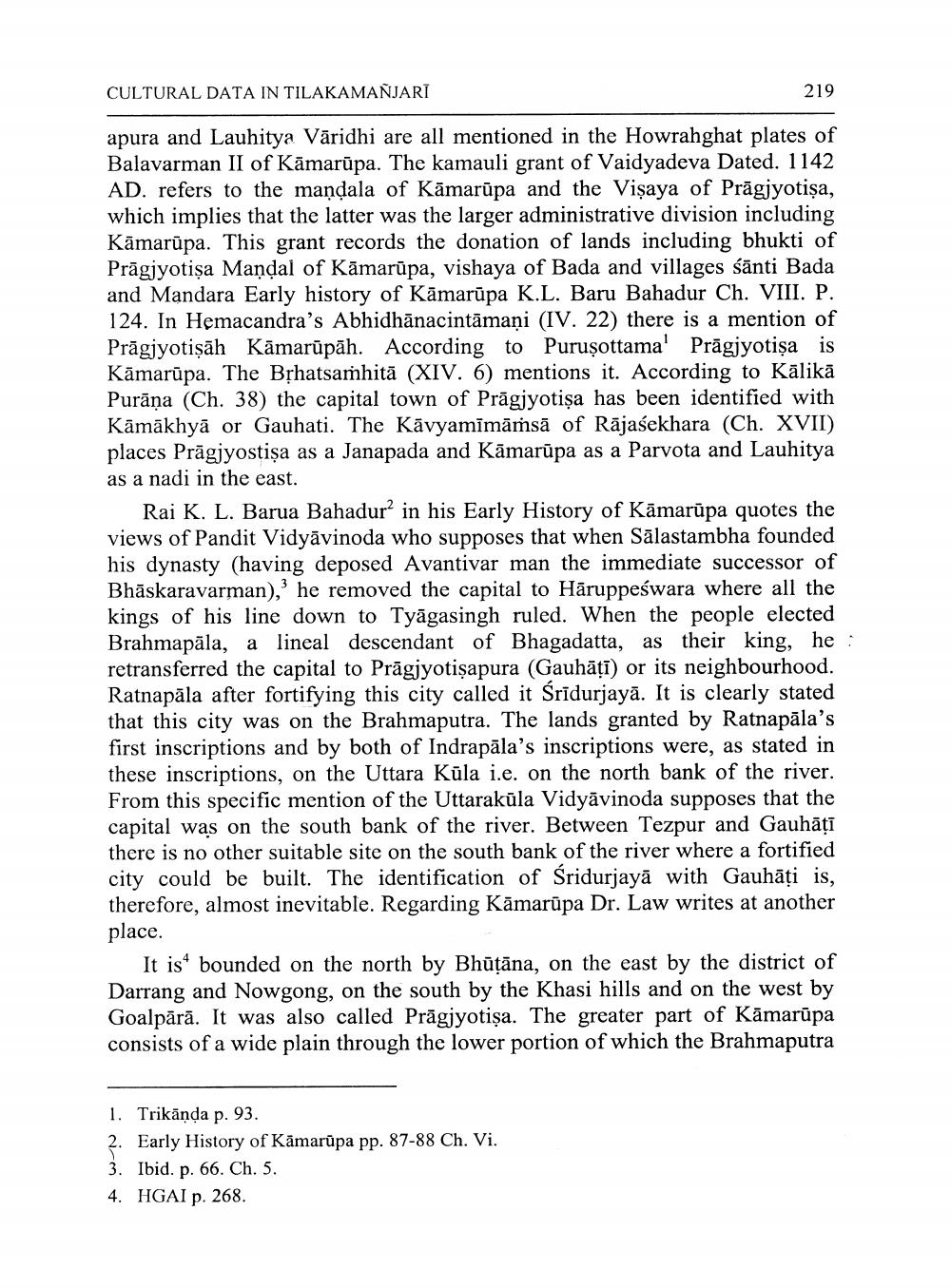________________
CULTURAL DATA IN TILAKAMANJARĪ
apura and Lauhitya Varidhi are all mentioned in the Howrahghat plates of Balavarman II of Kāmarupa. The kamauli grant of Vaidyadeva Dated. 1142 AD. refers to the mandala of Kāmarūpa and the Visaya of Prāgjyotiṣa, which implies that the latter was the larger administrative division including Kāmarūpa. This grant records the donation of lands including bhukti of Pragjyotiṣa Mandal of Kāmarupa, vishaya of Bada and villages santi Bada and Mandara Early history of Kamarupa K.L. Baru Bahadur Ch. VIII. P. 124. In Hemacandra's Abhidhānacintāmaṇi (IV. 22) there is a mention of Prāgjyotiṣāh Kamarūpāh. According to Purusottama' Pragjyotiṣa is Kamarupa. The Bṛhatsamhita (XIV. 6) mentions it. According to Kālikā Purāņa (Ch. 38) the capital town of Pragjyotiṣa has been identified with Kāmākhyā or Gauhati. The Kavyamīmāṁsā of Rajasekhara (Ch. XVII) places Prāgjyostișa as a Janapada and Kamarupa as a Parvota and Lauhitya as a nadi in the east.
219
Rai K. L. Barua Bahadur2 in his Early History of Kamarupa quotes the views of Pandit Vidyāvinoda who supposes that when Salastambha founded his dynasty (having deposed Avantivar man the immediate successor of Bhaskaravarman),3 he removed the capital to Haruppeśwara where all the kings of his line down to Tyagasingh ruled. When the people elected Brahmapāla, a lineal descendant of Bhagadatta, as their king, he : retransferred the capital to Pragjyotiṣapura (Gauhāṭī) or its neighbourhood. Ratnapāla after fortifying this city called it Śrīdurjaya. It is clearly stated that this city was on the Brahmaputra. The lands granted by Ratnapāla's first inscriptions and by both of Indrapala's inscriptions were, as stated in these inscriptions, on the Uttara Kūla i.e. on the north bank of the river. From this specific mention of the Uttarakūla Vidyāvinoda supposes that the capital was on the south bank of the river. Between Tezpur and Gauhāṭī there is no other suitable site on the south bank of the river where a fortified
city could be built. The identification of Śridurjaya with Gauhāți is, therefore, almost inevitable. Regarding Kamarupa Dr. Law writes at another place.
It is bounded on the north by Bhuṭāna, on the east by the district of Darrang and Nowgong, on the south by the Khasi hills and on the west by Goalpārā. It was also called Pragjyotiṣa. The greater part of Kamarūpa consists of a wide plain through the lower portion of which the Brahmaputra
1. Trikāṇḍa p. 93.
2. Early History of Kamarupa pp. 87-88 Ch. Vi.
3. Ibid. p. 66. Ch. 5.
4. HGAI p. 268.




